
Why Hot Weather Matters in Concrete Construction
Extreme summer temperatures can drastically affect concrete quality and performance. Fresh cement is sensitive to environmental changes, especially when temperatures soar, creating a blend of challenges for construction teams. Maintaining optimal conditions during application is crucial; it’s recommended that the concrete mix be poured when the temperature hovers between 10 to 30°C. Failure to adhere to these standards can compromise the strength and longevity of concrete structures.
Understanding the Risks of Concreting in High Temperature
High temperatures are notorious for increasing the rate of water evaporation and accelerating cement hydration. This combination leads to the dreaded slump loss and increased concrete demand, where the concrete mix becomes too dry or hardens too quickly. Construction teams face challenges like:
- Increased setting rate, making it difficult to manipulate the concrete.
- Rapid evaporation resulting in quality compromise and shrinkage cracks.
- Need for increased curing efforts to ensure proper hydration.
- Shorter window for effective placement and finishing of concrete.
Smart Strategies for Mitigating Hot Weather Challenges
Addressing the arduous effects of hot weather requires proactive measures at the construction site. Here are some effective strategies:
- Pre-Cooling Techniques: Before pouring, sprinkle cool water onto the formwork or substrate to lower its temperature and minimize the risk of excessive heat absorption.
- Optimal Planning: Schedule mixer trucks strategically to avoid unnecessary delays during concrete delivery, thus keeping the mix workable and fresh.
- Timing Matters: If feasible, plan concrete placement for early morning or night when temperatures are cooler, reducing stress on the concrete.
- Efficient Logistics: Streamline placement and curing processes to minimize exposure to harsh environmental conditions.
The Role of Admixtures in Hot Weather Concreting
Concrete admixtures serve as essential allies in overcoming the adverse impacts of extreme heat. These additives can enhance the hydration rate, leading to improved strength, durability, and permeability. When used appropriately, admixtures help maintain a consistent temperature for concrete, crucial for its overall success. A few commonly utilized admixtures in hot weather include:
- Plasticizers that assist in achieving targeted workability without increasing water content.
- Retarders that slow down the setting time, providing more flexibility during placement.
- Hydration-control agents that help balance the temperature throughout the curing process.
Conclusion: Elevate Your Construction Game
In unpredictable weather conditions, being prepared is non-negotiable for business owners and property developers. By implementing thoughtful strategies and utilizing the right admixtures, you can ensure that concrete remains strong and sustainable, even in the face of summer heat. For detailed solutions tailored to your specific construction needs, reach out to local admixture companies today to explore eco-friendly and performance-enhancing options that align with your values.
 Add Row
Add Row  Add
Add 




 Add Row
Add Row  Add
Add 

Write A Comment